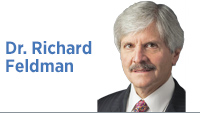Subscriber Benefit
As a subscriber you can listen to articles at work, in the car, or while you work out. Subscribe Now If you had only one person to turn to for medical advice or to help you resolve a health problem, who would that person be?
If you had only one person to turn to for medical advice or to help you resolve a health problem, who would that person be?
If you answered “my doctor,” you are not alone.
More than 75% of Hoosiers 40 years old and up responded in a recent survey that they most trust their physicians to lead and coordinate their health care. It makes sense given the demanding and comprehensive training physicians undergo.
This training takes seven to 12 years to complete, including four years of medical school and three to eight years of residency and fellowship to accumulate 10,000 to 16,000 clinical hours to prepare doctors for the enormous responsibility of being entrusted with the lives of their patients.
As with most professions, physicians do not work alone. Health care is often delivered with a team-based approach that includes a doctor and other valued professionals working together for the benefit of patients. Every health care worker has a unique role to play, given their clinical training and experience.
But the training of other team members is not equivalent to that of physicians. For example, nurse practitioners (APRNs) average 750 hours of clinical training, and physician assistants average 2,000 hours. Nearly 40% of individuals surveyed believe nurse practitioners complete the same training as a physician. There are also qualitative differences in training. Physicians benefit from much deeper and more complex and intensive training. Given the educational differences, it’s up to physicians to lead this team.
I bring all this up to introduce an alliance that formed last year of more than 10 statewide physician professional organizations working together to advocate for Hoosier patients. The Indiana Physician Coalition (INphysicians.org) educates the public and lawmakers on how physician-led health care can best promote patient safety, increase access to quality care, and help control health care spending. The coalition was formed at a time various health care professionals have sought greater autonomy or, in the case of nurse practitioners, complete independent practice.
That recent survey also reveals that 83% of Hoosiers believe physicians and nurse practitioners need to work in a coordinated manner, that 76% believe—in the event of a medical complication or emergency—a physician’s involvement is necessary, and that 73% believe nurse practitioners treating patients with chronic diseases should be overseen by physicians.
Further, with the blurring of roles, many patients are often left confused about whether they were seen by a physician or another provider during a medical encounter. The coalition supports these patient concerns and perspectives of what Indiana medicine should look like to improve their health and well-being.
The coalition’s goals have been furthered by the Indiana General Assembly. For example, in 2015, lawmakers created a program called the Graduate Medical Education Board that creates new residency training opportunities to keep more graduating medical students in-state and increase physician supply. So far, more than 70 physicians and 220 residency slots have been created as a result of this program, many serving rural and underserved areas.
This is a huge win for Indiana patients as well as for communities. The economic impact of the physicians created by these programs is expected to reach $332 million by 2025. It’s critical that funding for this program is maintained during the 2021 legislative session.
Hoosiers have the greatest trust in physicians for their health care. With more physicians, more physician-led teams are available to increase health care access and best serve the medical needs of Indiana.•
__________
Feldman is a family physician, author, lecturer and former Indiana State Department of Health commissioner for Gov. Frank O’Bannon. Send comments to ibjedit@ibj.com.
Click here for more Forefront columns.
Please enable JavaScript to view this content.
